Want to boost your garden’s health, enhance pollination, and control pests naturally? You can attract beneficial insects like ladybugs and lacewings by starting with native flowers. Plant coneflowers or black-eyed Susans, which bloom in 6-8 weeks, and place them in sunny spots with well-drained soil, about 12-18 inches apart. There’s more to this strategy, though, so stick around for tips to transform your yard into an insect haven.
Contents
Planting Native Flowers
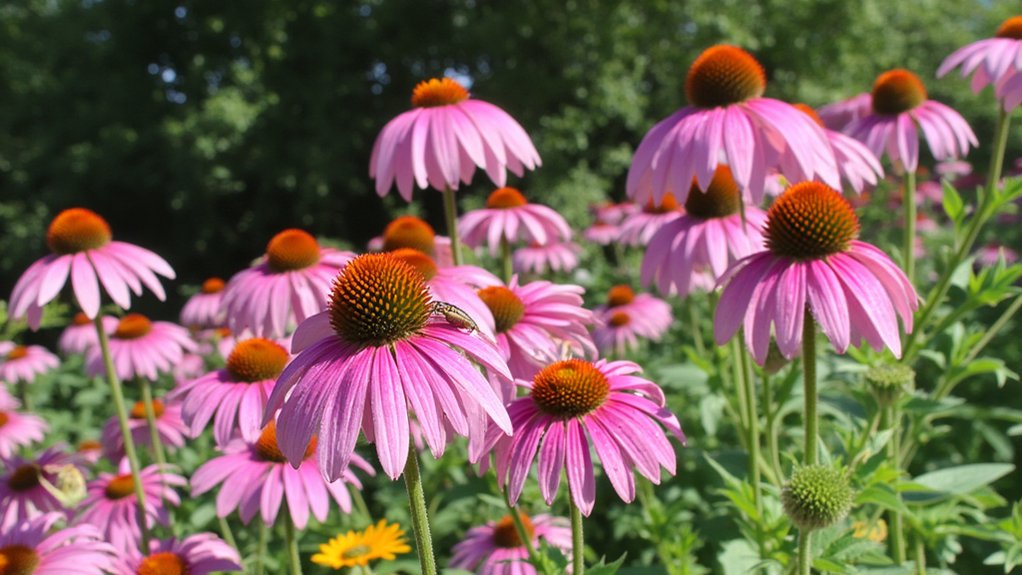
While you might be tempted to plant exotic blooms, let’s start with native flowers to attract beneficial insects. You’ve got local options like coneflowers, black-eyed Susans, or milkweed, which thrive in your region. They’re adapted to your climate, so they need less fuss.
Pick a sunny spot, ideally 6-8 hours of light daily, and prepare the soil. Loosen it to a depth of 12 inches, mix in compost, and plant seeds or seedlings in early spring. Water them every 2-3 days until established, about 1 inch per session.
These flowers draw pollinators like bees and predatory insects like lacewings. Check for blooms in 6-8 weeks, and keep weeds at bay. You’re building a haven, naturally!
Building Insect Hotels
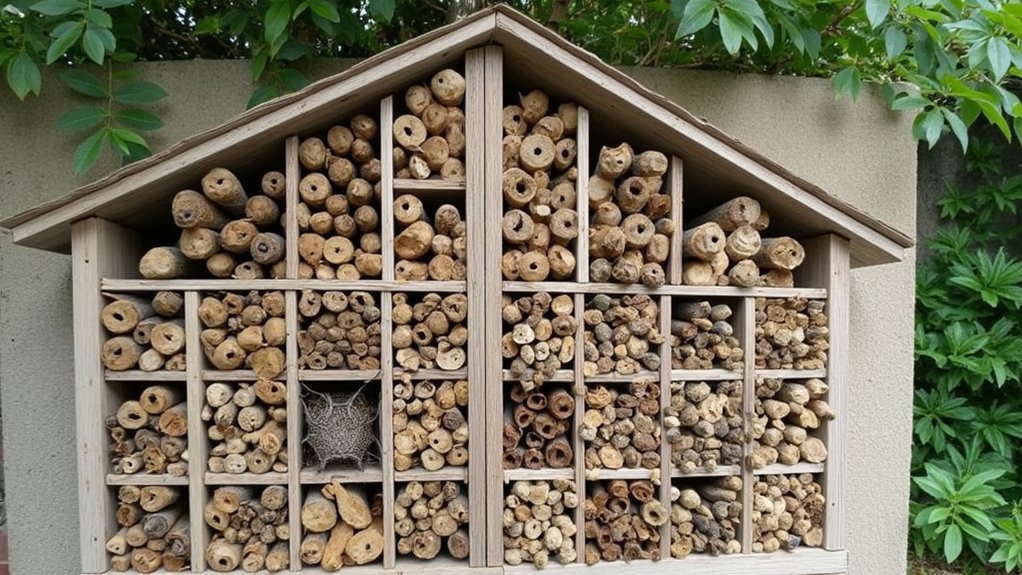
As you set up your garden to welcome beneficial insects, let’s plunge into building insect hotels for extra support. These little shelters offer safe spots for bugs like ladybugs and lacewings. You’ll help them stick around to protect your plants.
Start by grabbing a wooden box, about 12 inches tall and wide. Fill it with natural materials—think hollow bamboo sticks, pinecones, and bark. Stack them tightly, leaving small gaps for insects to crawl in, ideally 2-8 millimeters wide.
Place your hotel in a quiet, sheltered spot, like near a hedge, about 3-5 feet off the ground. Face it toward the sun for warmth. Check it every few months, replacing damp or moldy materials. Soon, you’ll have tiny guests moving in!
Avoiding Pesticide Use
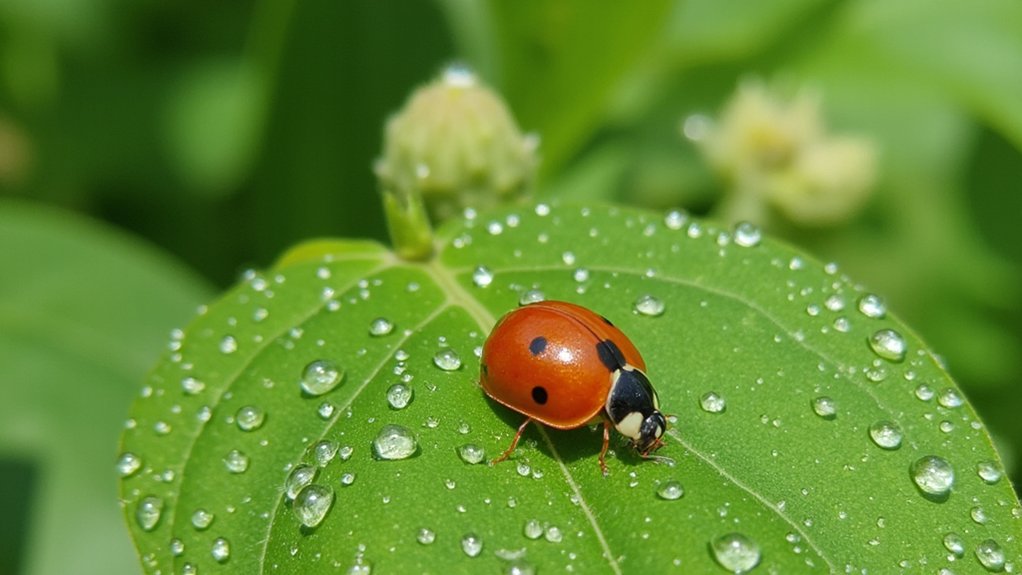
Before you reach for that pesticide spray, consider the harm it can do to your garden’s helpful insects. Ladybugs, lacewings, and hoverflies, which eat pests, often get killed by chemicals. You’re wiping out your natural allies!
Instead, try safer alternatives to manage pests without harm. Use neem oil, a natural repellent, applying 1 teaspoon per quart of water, sprayed weekly. It’s effective against aphids but gentler on beneficial bugs. Or, hand-pick pests like caterpillars off plants every morning for a quick fix.
If you must use a pesticide, choose targeted ones, like insecticidal soaps, and apply them at dusk. This timing, around 7-8 PM, avoids peak activity of good insects. Protect your garden’s helpers; they’re working hard for you!
Providing Water Sources
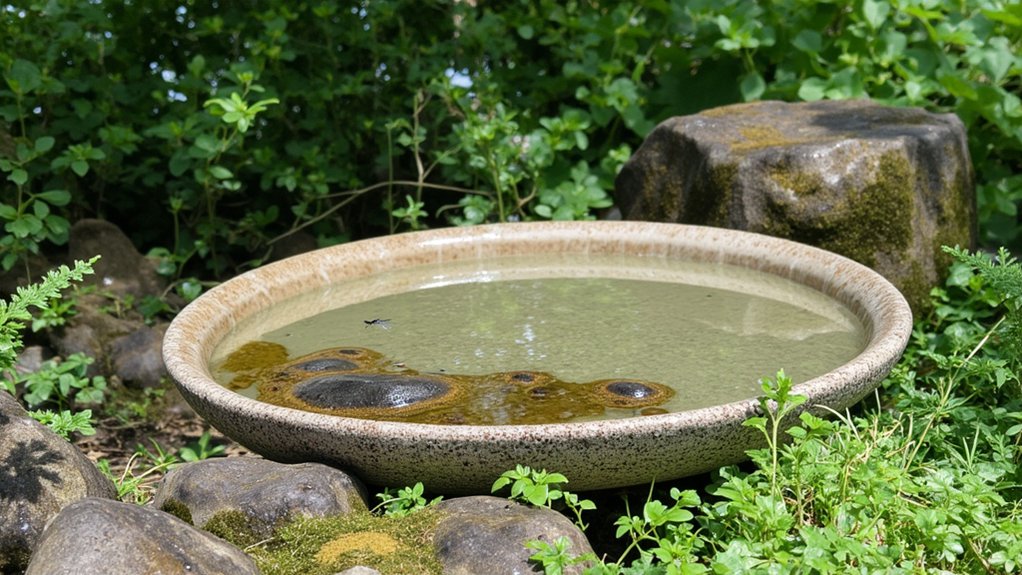
Since beneficial insects need hydration to thrive, let’s set up some water sources in your garden. You can start with a shallow dish, like a pie tin, filled with clean water. Place it near ground level, ideally in a shaded spot, to keep it cool. Add small pebbles or marbles so insects can land safely without drowning.
Now, check the water daily, refilling it if it’s low, especially during hot, dry spells. Position a few of these dishes, about 10 feet apart, across your garden for easy access. For a quick DIY drip, poke tiny holes in a plastic bottle, bury it halfway, and fill it with water. This slow release keeps moisture steady for thirsty critters all day long.
Creating Diverse Plantings
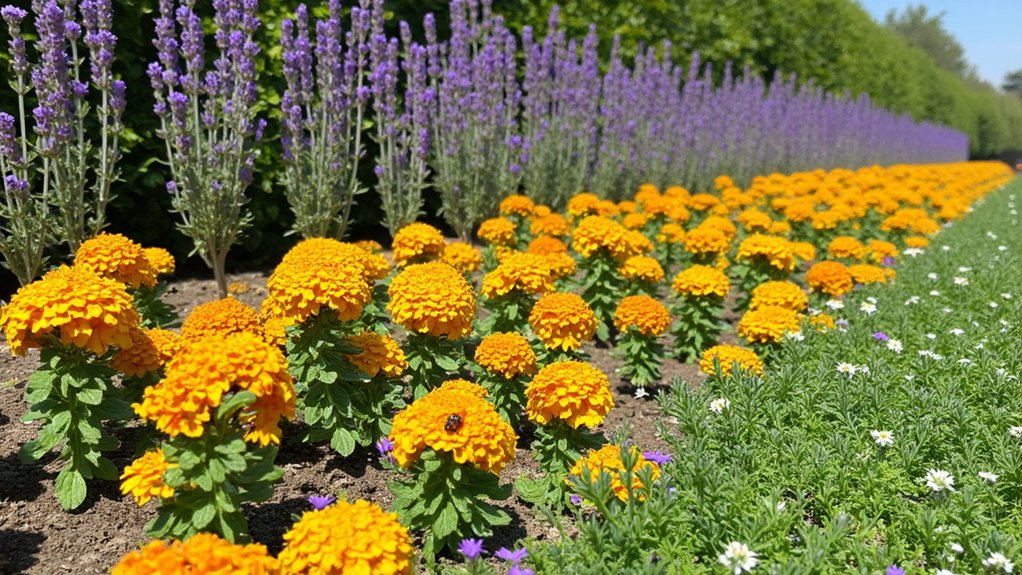
While you’re setting up water sources, let’s plunge into creating diverse plantings to draw in beneficial insects. Mix up your garden with various plants, like herbs, flowers, and veggies. Aim for a blend of heights—think tall sunflowers, medium zinnias, and low-growing thyme—to offer shelter and food.
Start by mapping out a 10×10-foot plot, if possible, for diversity. Plant nectar-rich blooms, such as lavender or marigolds, near crops like tomatoes to lure pollinators and predators. Rotate species yearly to keep pests guessing and maintain soil health.
Don’t skimp on variety; include at least five different plant families. This mix guarantees insects like ladybugs and lacewings stick around. Keep it simple, but strategic, and watch your garden buzz with helpful critters.
Adding Leaf Litter
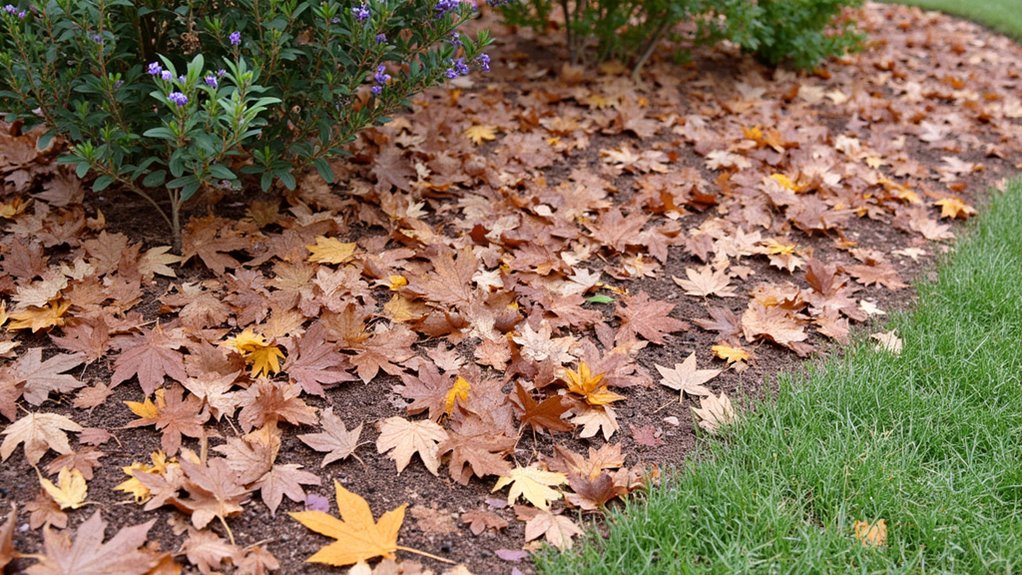
As you build on your diverse plantings, let’s tackle adding leaf litter to boost your garden’s appeal for beneficial insects. It’s a simple trick, often overlooked, but incredibly effective. Leaf litter provides shelter for critters like ground beetles and ladybugs, which munch on pests.
Start by gathering dry leaves in fall, aiming for a 2- to 4-inch layer. Spread this over bare soil areas, especially near perennials or shrubs, but avoid piling it against plant stems to prevent rot. This cozy cover, mimicking a natural forest floor, keeps insects safe during winter.
Check the layer monthly, adding more if it thins below 2 inches due to wind or decomposition. You’re creating a haven, so keep it consistent!
Installing Bat Houses
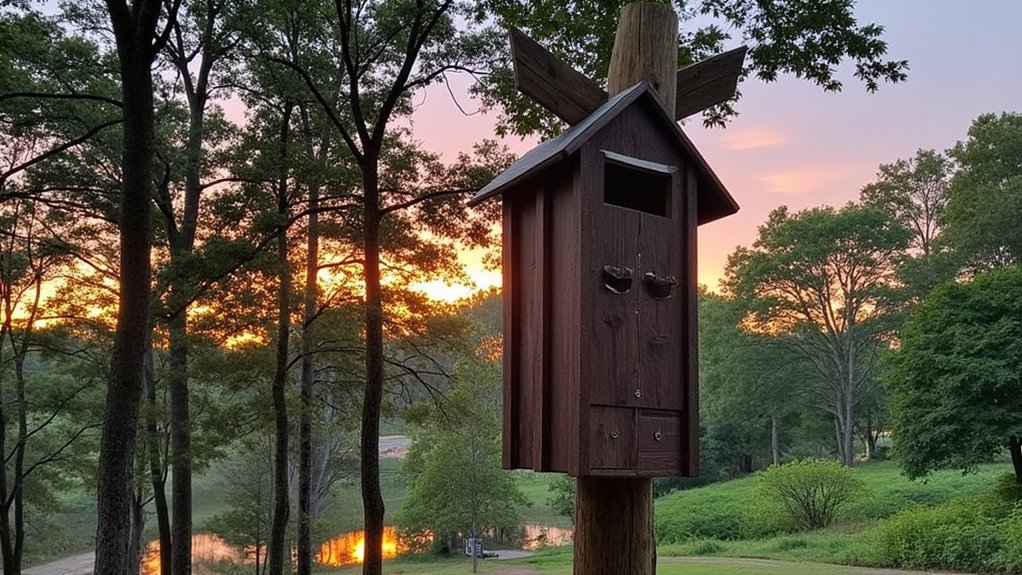
Hey, let’s plunge into installing bat houses to draw some awesome pest controllers to your garden. Bats devour tons of insects nightly, so they’re a fantastic ally. You’ll want to help them settle in right.
Start by picking a spot 10-20 feet off the ground, ideally on a pole or tree. Make sure it’s near water or trees, as bats love these hangouts for navigation. Face the house southeast for morning sun, ensuring warmth.
Next, grab a bat house with a rough interior—bats need grip to roost. Mount it securely with screws, not nails, to avoid wobbling. Paint it a dark color if you’re in a cooler climate for extra heat. Check it after a month; bats might move in soon!
Growing Companion Plants

Before you immerse yourself in planting, let’s talk about growing companion plants to boost your garden’s health. These plants, when paired wisely, can naturally repel pests and attract helpful insects. Think of them as your garden’s best buddies.
Start by planting marigolds near your tomatoes; their strong scent deters harmful bugs. Space them about 12 inches apart for good coverage, and plant them in early spring. This combo works wonders in small or large plots.
Next, try basil alongside peppers to enhance growth and keep unwanted critters at bay. Sow basil seeds directly in the soil, roughly 10 inches from peppers, after the last frost. Check weekly for overcrowding. With these pairings, you’re setting up a thriving, balanced garden ecosystem.
Offering Pollen-Rich Plants
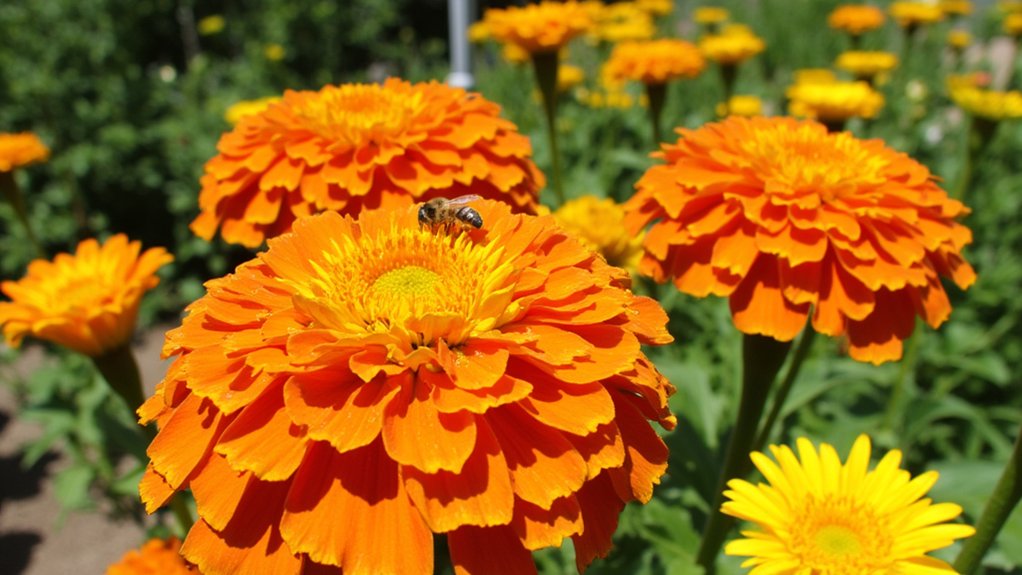
Let’s shift gears and talk about offering pollen-rich plants to draw in beneficial insects. You’ve gotta give pollinators, like bees and hoverflies, a reason to visit. Plant flowers packed with pollen, such as marigolds, sunflowers, or cosmos, in your garden beds.
Start by choosing a sunny spot, ideally 6-8 hours of direct light daily, since these plants thrive there. Sow seeds in early spring, spacing them 12-18 inches apart, and water them lightly every 2-3 days until they sprout. Once established, they’ll bloom for weeks, providing a steady food source.
Keep an eye on them, and deadhead faded flowers to encourage more blooms. This simple step guarantees insects stick around, helping your plants flourish with ease.
Setting up Toad Shelters
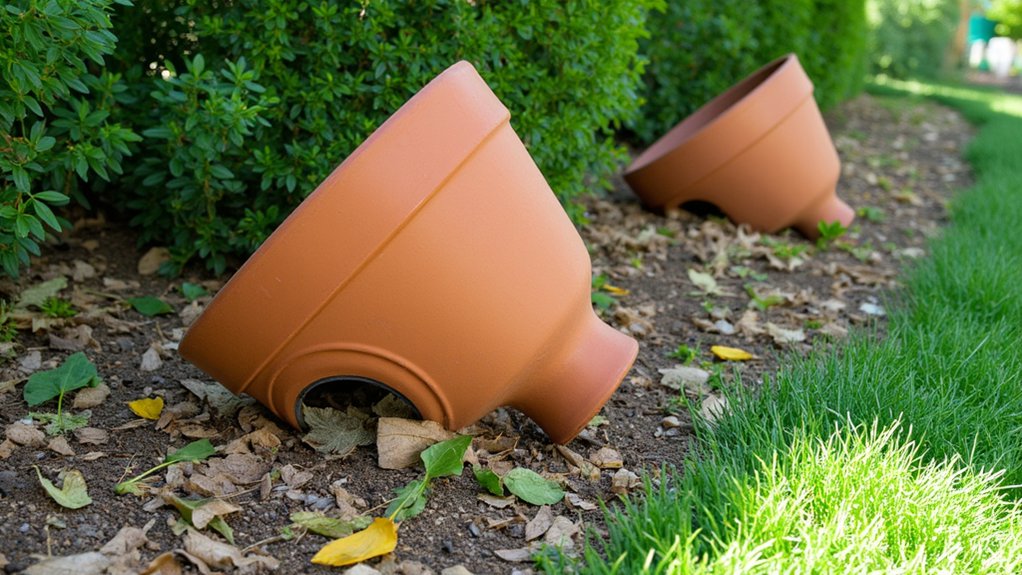
While you’re boosting your garden with beneficial insects, consider setting up toad shelters to invite natural pest controllers. Toads gobble up slugs, snails, and bugs, so they’re handy allies. Let’s get started with a simple setup.
Grab an old clay pot, about 6-8 inches wide, and crack it halfway to make a small entrance. Place it upside down in a shady, damp spot near plants—think under a bush or by a water source. Add some moist leaves inside for comfort, and check weekly to verify it’s not too dry.
Don’t overthink it; just keep the shelter low, around 3-4 inches off the ground. Within a few weeks, you’ll likely spot toads moving in, munching pests quietly. How’s that for easy pest control?
